Five key levers for sustainable healthcare
May 01, 2024 | 12 minute read
Climate change, pollution and biodiversity loss are impacting the lives and livelihoods of hundreds of millions of people around the world, often hitting the most vulnerable communities especially hard.
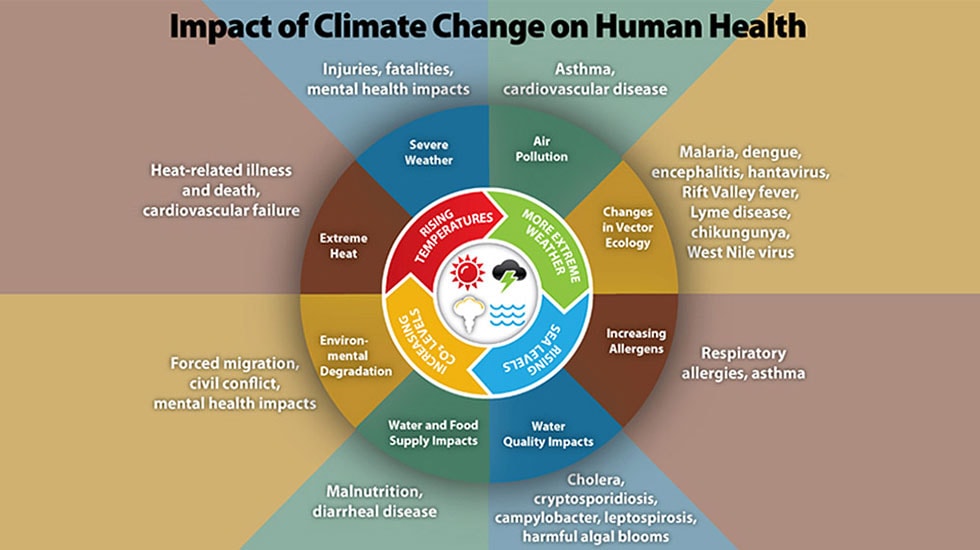
Source: CDC – Centers for Disease Control and Prevention
According to the US-based CDC (Centers for Disease Control and Prevention), climate impacts such as rising temperatures, extreme weather events and rising CO₂ levels affect a wide range of health outcomes. Air pollution leads to increased rates of asthma and cardiovascular disease, and heat-related diseases and Non-Communicable Diseases (NCDs, such as Malaria, Dengue) are on the rise [1].
We’ve been given a warning by science and a wake-up call by nature; it is up to us now to heed them.
Significant opportunity
As far back as 2015, the Lancet Commission stated, “Tackling climate change could be the greatest global health opportunity of the 21st century.” And it still is. Fortunately, health leaders are increasingly recognizing this potential, as well as the crucial role environmental sustainability plays in achieving long-term population health goals. Patients too expect hospitals to be environmentally conscious: one survey showed that 92% of UK patients found it important for their healthcare systems to operate more sustainably [2].
That said, if healthcare were a country, it would be the world’s fifth-largest emitter of CO₂, accounting for over 4% of global emissions – more than the aviation or shipping sectors [3]. This means that, as an industry, we – health technology companies, healthcare systems, suppliers and other stakeholders across the healthcare value chain – have an urgent responsibility to act.
It is time to extend the principle of First, do no harm – the very bedrock of healthcare – to the planet. The good thing is that taking better care of the planet will enable us to provide better care for more people and so increase our social impact.
There is a lot that health technology companies like Philips can do today to help health systems reduce their environmental footprint and integrate sustainable ways of working, while at the same time supporting better health outcomes, reducing the cost of care, and advancing health equity and access to care.
So, what are the strategies that health systems can adopt now to help achieve these goals?
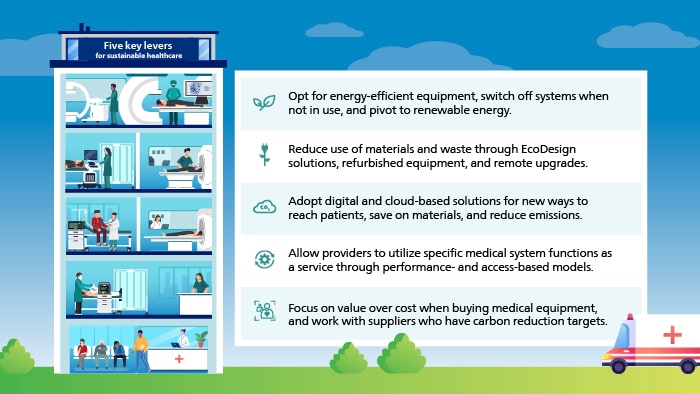
1. Increase energy efficiency and use of renewable energy
Hospitals have the highest energy intensity of all publicly funded buildings and emit 2.5 times more greenhouse gas than commercial buildings [4].
At Philips, energy consumption during the customer use phase of our products accounts for the vast majority of our total environmental impact. That’s why improving the energy efficiency of our products is a key priority for our EcoDesign program.
Our Azurion image-guided therapy platform, for example, offers at least a 10% reduction in energy consumption over its total product life usage compared to its predecessor [5]. However, when it comes to saving energy, it’s not all about the technology: sustainable user behavior can also make a significant difference. Radiologists, for example, can actively help to reduce the energy consumption of Philips’ MR systems by switching their system to power-saving mode or off when not in use and in between scans.
Philips actively supports a voluntary industry initiative with European trade association COCIR to improve the energy efficiency and material efficiency of medical imaging equipment [6]. As part of the EU Green Public Criteria for medical devices, COCIR has developed methodologies to provide purchasers with all the information they need to calculate running costs and to choose the best equipment for their needs.
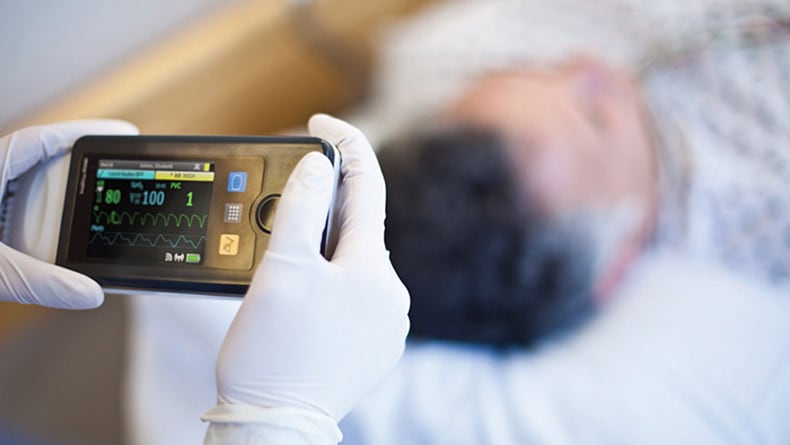
For large-scale, energy-intensive operations like hospitals, pivoting to renewable energy can have a major impact. Partnering with like-minded peers can help achieve the necessary scale. For example, the opening of Mutkalampi windfarm in Finland in 2023, supported by a consortium of partners, adds significant clean electricity to the European grid. This will help to power Philips’ global operations for the next 10 years, and support customers’ transition to sustainable healthcare. Philips also recently signed its first direct renewable energy agreement in China.
2. Increase circularity and reduce waste
We need to design circular systems, which respect the constraints on the planet’s resources. This requires collaboration across the value chain, a deep understanding of material flows, and focusing on what truly creates value for our customer.
Some 45% of global CO₂ emissions are attributable to materials extraction, supply, and the manufacture of materials, products and food, as well as land management – often referred to as ‘embedded carbon’ [7]. Healthcare is a huge consumer of natural resources, accounting for 10% of raw materials extracted globally every year [8]. It is, therefore, crucial that we find ways to use materials for medical systems and devices in a sustainable manner. Our ambition is to help our customers to ‘do more with less’. We do this by applying our circularity principles – Use less, use longer, use again – across the value chain.
The noble gas helium, for example, is essential to maintaining the long-term availability of MR scanners, yet its global supply is limited. At Philips, we have developed BlueSeal, a fully sealed magnet that supports the transition to sustainable, helium-free-for-life MR operations, as well as simplifying installation and reducing expensive disruptions to MR services. In contrast to conventional magnet technology, which requires around 1,500 liters of liquid helium for cooling during operation, BlueSeal uses highly efficient, micro-cooling technology, which requires just 7 liters of liquid helium for cooling – less than 0.5% of today’s volume [9]. With over 1,060 units installed globally, MRI scanners equipped with Philips' BlueSeal magnet technology have already saved more than 1.9 million liters of helium since 2018 (saving calculation based on comparison with a conventional magnet with 1,500 liters of helium).
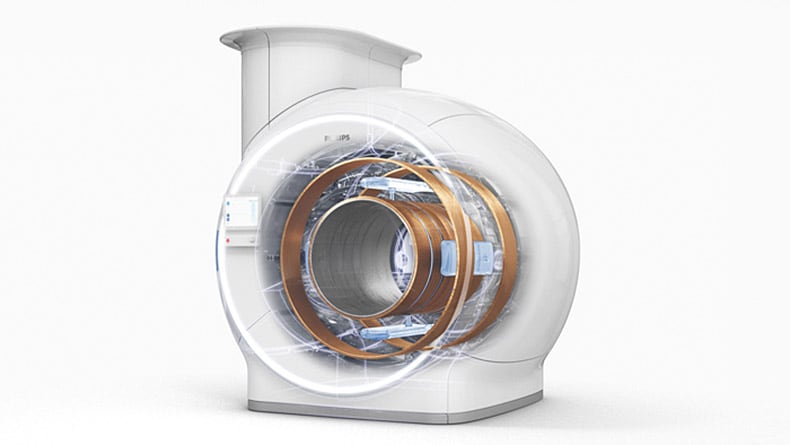
In many cases, healthcare providers can maximize the return on their initial investments and extend their capabilities through on-site or remote upgrades, instead of having to buy new equipment. Our SmartPath for MR portfolio, for example, enables customers to re-use their existing magnets and convert them to the next generation of MR – all without the inconvenience of installing a new system, and at a fraction of the cost. This form of upgrade is also a sustainable choice, as it avoids the energy usage and carbon dioxide production caused by the manufacture and transportation of a new magnet. And thanks to software upgrades like SmartSpeed, our MR systems can scan up to three times faster [10], while reducing power consumption by, on average, 32% per patient scan [11] using the same equipment.
With healthcare funding under constant pressure, care providers are often looking to expand their resources within a limited budget – but without compromising on quality. As a member of DITTA, Philips is a committed advocate of trade-in, responsible (end-of-use) management of materials and products, and refurbishment of medical imaging equipment. Philips Circular Edition allows customers to benefit from fully refurbished and quality-tested technology at lower cost. In this way they can extend the delivery of clinical care while reducing their environmental impact.
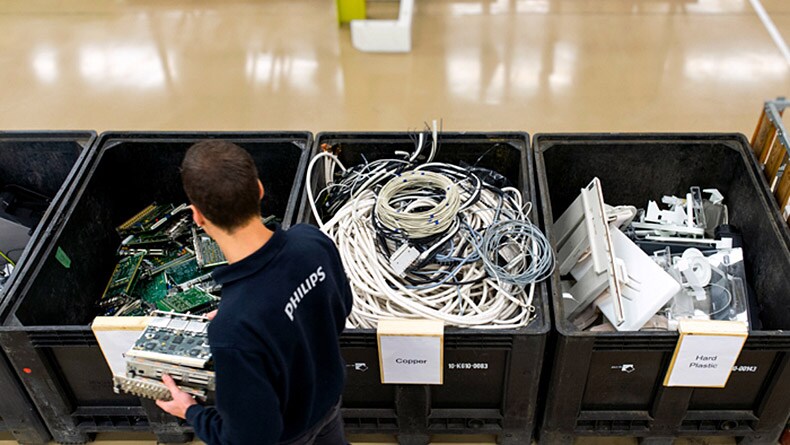
If refurbishment is no longer a possibility, Philips will also take back the currently installed Philips equipment and ensure responsible end-of-use management, to prevent waste going to landfill. By recovering valuable parts, we can service older systems, maximizing lifetime value again. If that is no longer an option, we recycle back to raw materials locally via our certified global recycling networks.
Hospitals produce 13 kg of waste per bed per day, of which 15-25% is hazardous waste [12]. Healthcare facilities generate a lot of waste, including sharps, trace chemotherapy and pathological waste. Medical consumables – which have a short use life – are used in massive quantities. Consequently, they represent a major source of waste, adding to the financial pressure on health systems.
At Philips, our EcoDesign program supports our ambition to design out waste and pollution, and drive the responsible use of resources. EcoDesign is fully embedded in our innovation processes and drives improvements in four ‘Green Focal Areas’ – energy, substances, packaging, and circularity. For example, we are collaborating with our customers to optimize the lifetime of medical consumables materials and so minimize unnecessary disposal.
3. Drive digitalization for more equitable and sustainable care
Digital health technology and AI are central to making health systems more efficient, productive and financially sustainable. They offer new ways to reach patients, connecting them with the care they need at the time they need it, while at the same time reducing environmental impact and the cost of care.
Digital solutions support ‘dematerialization’ by delivering maximum value with minimum materials, thus helping to avoid unnecessary use of resources. We see this driving a shift from resource-intensive clinical facilities to networked lower-cost settings and the home, thereby improving health equity and expanding access to care.
Today, patients often have to attend multiple appointments for diagnosis, treatment and monitoring. This can involve repeated, sometimes arduous, journeys. The adoption of digital technology and network infrastructure supports prevention and telehealth, or ‘virtual care’, by enabling remote interaction between patients and care givers, thus reducing the related travel and CO₂ emissions.
We also see dematerialization in the form of the transition to cloud-based solutions, which supports savings on the materials required for on-site enterprise hardware and a reduction in CO₂ emissions. Studies have shown that when customers switch from on-premises infrastructure to large, centralized cloud-based data centers, power consumption decreases by 84% [13] and they require only one quarter of the servers [14].
We are also addressing ‘digital waste’, in order to improve health systems’ efficiency and performance, while at the same time reducing their environmental footprint. This means, for example, designing efficient workflows that can help get scans right first time (avoiding the need for additional scans) or getting patients home a day earlier (helping our customers to reduce costs and waste).
4. Adopt innovative service models
For our customers and their patients, a system’s functionality and quality of service are what matter, not the system itself. It’s all about being able to offer the best possible imaging and informatics & analytics to improve patient cares and drive better health outcomes – not a specific piece of equipment.
Performance- and access-based models allow care providers to utilize specific functionality as a service. Our Lumify with Reacts portable ultrasound service is a good example. Under this flexible subscription model, users have access to transducers, an app and online ecosystem, reducing upfront capital expenditure and improving patient access to innovative care.
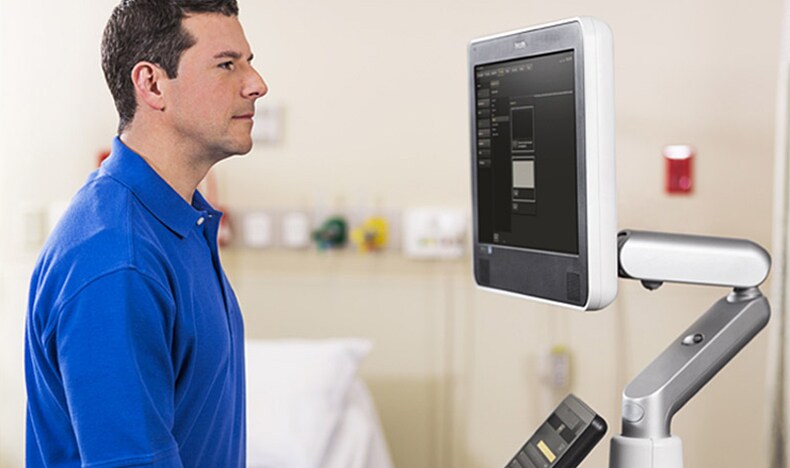
Similarly, under our Enterprise Monitoring as a Service (EMaaS) model, Philips retains ownership of the patient monitoring system and is responsible for all hardware, software, and networking upgrades across its network, while the customer pays a per-patient fee.
5. Buy sustainably and decarbonize the supply chain
The supply chain (scope 3, purchased goods and services) is responsible for 71% of CO₂ emissions [3].
Procurement teams in healthcare have the opportunity to lead and scale change by looking at the way things are done through a sustainability lens, with a focus on value-based rather than cost-based sourcing. More and more, care providers are applying Green Procurement criteria when buying medical equipment, and incorporating minimum standards for sustainability in Request for Proposal (RFPO) or tender procedures. Going forward, it is expected that, in the EU and US, this will increasingly be mandated by Green Procurement standards.
We believe that sustainable procurement is one of the key strategies that health systems and governments can adopt right now to reduce their environmental footprint – and so help ‘take the carbon out of healthcare’. To help buyers ask the right question, Philips has identified five priority themes and recommended assessment criteria for public-sector purchasers in Europe to apply when procuring medical equipment and health technology solutions. These recommendations have helped inform DITTA and COCIR’s sustainable procurement drive.
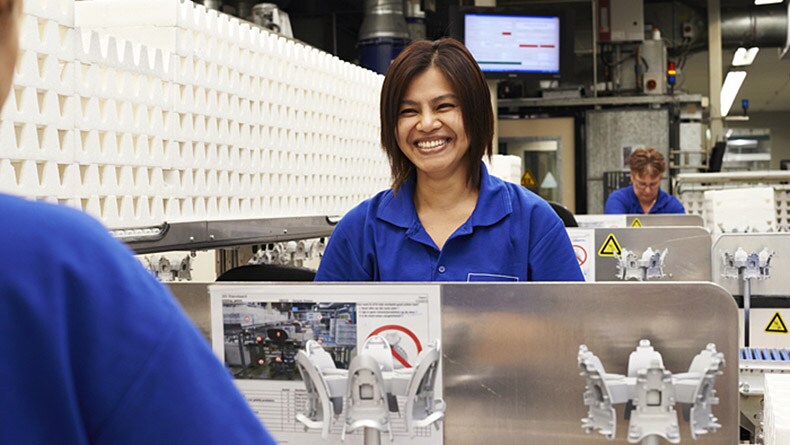
If we are to succeed in decarbonizing healthcare, it is essential to take an end-to-end view of the value chain. One way healthcare providers can magnify their impact is to work with suppliers who have committed to science-based targets for carbon reduction. In 2018, Philips became the first health technology company to have its CO₂ emission targets assessed and approved by the Science Based Targets initiative (SBTi). Today, we are going even further, stepping up our supplier sustainability program so that at least 50% of our suppliers (based on spend) will have committed to science-based targets for carbon reduction by 2025. By supporting and incentivizing our suppliers to adopt and meet such targets, we believe we can achieve a sevenfold greater impact than simply lowering CO₂ emissions from our own operations.
In 2022, Philips became the first health technology company with approval from the Science Based Targets initiative (SBTi) for its full-value-chain (scope 1-3) CO₂ emissions reduction targets. And in our Annual Report 2023, we published our full-value-chain emissions for the first time, audited at the highest assurance level.
Time to team up and take action!
Climate change is the single greatest threat to a sustainable future but, at the same time, addressing the climate challenge presents a golden opportunity to promote prosperity, security and a brighter future for all.
Leadership commitment to drive change and sustainability across the healthcare value chain – procurement, operations, innovation, service delivery, etc. – is vital if we are to reduce healthcare’s environmental impact. And it’s not a voluntary 'nice to have': with increasingly stringent environmental legislation on the way in many countries, it makes sense to get ahead of the curve. Setting ambitious targets and committing to report progress on a regular basis are crucial first steps. After that, it’s all about collaborating closely with others in the ecosystem – including care providers, clinical practitioners, knowledge partners and suppliers – to implement change and deliver on commitments.
At Philips, we work together with our customers to help them address their clinical and operational challenges, while at the same time adopting sustainable ways of working. For example, we are partnering with Portugal’s Champalimaud Foundation with the aim of halving their diagnostic imaging carbon footprint within five years.
We actively encourage all our partners across the value chain to implement sustainable and circular ways of working within their organizations. At the same time, governments can support and stimulate a green approach by setting clear standards, rules and guidelines that apply to all companies, in order to create a level playing field and drive decarbonization across the board. Businesses need this clarity of purpose.
With our collective expertise, innovative capability, and shared awareness of the need to drive change, we can combine sustainable practices with the safe, efficient and effective delivery of care. Now is the time for healthcare providers, health technology companies, governments and other stakeholders to join together and deploy the strategies, solutions and services that can deliver more resilient and sustainable healthcare for the generations to come.
Sources [1] https://www.who.int/news/item/02-11-2023-climate-change-and-noncommunicable-diseases-connections
[2] https://www.ncbi.nlm.nih.gov/pmc/articles/PMC10689521/#CR2
[3] Health Care Without Harm (2019). Healthcare’s climate footprint: How the health sector contributes to the global climate crisis and opportunities for action
[4] https://www.ecomedsupply.com/Healthcare-Impact-on-Environment-s/1739.htm
[5] Determined via the COCIR SRI method. Compared to predecessor Allura Xper platform. Exact energy reduction depends on configuration.
[6] https://www.cocir.org/initiatives/ecodesign-initiative/saving-energy.html
[7] https://www.ellenmacarthurfoundation.org/completing-the-picture
[8] Circular Economy – Circularity Gap Report 2020
[9] https://www.philips.com.au/healthcare/resources/landing/the-next-mr-wave/sealed-mr-technology
[10] Compared to Philips SENSE
[11] Applicable to MR 5300 and Ambition S. Philips SmartSpeed power consumption versus Philips SENSE-based scanning. Based on COCIR and in-house simulated environment. Results can vary based on site conditions.
[12] https://practicegreenhealth.org/topics/waste/waste-0
[13] https://www.accenture.com/us-en/insights/strategy/green-behind-cloud
[14] https://www.nrdc.org/sites/default/files/data-center-efficiency-assessment-IP.pdf








